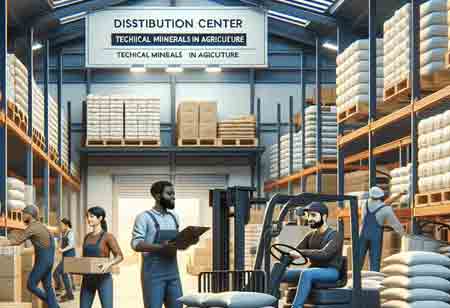Thank you for Subscribing to Agri Business Review Weekly Brief
The New Geography of Distribution: Mapping Consolidation and Localization in Agri-Supply Chains

By
Agri Business Review | Tuesday, August 05, 2025
Stay ahead of the industry with exclusive feature stories on the top companies, expert insights and the latest news delivered straight to your inbox. Subscribe today.
The agricultural product distribution sector stands at a pivotal juncture, experiencing an interplay of forces that are fundamentally reshaping its landscape. From the strategic responses of regional distributors to the pervasive influence of digital technologies and the evolving, data-centric purchasing behaviors of farms and co-ops, the industry is in a constant state of transformation.
Consolidation vs. Localization: A Shifting Balance
The agricultural distribution sector is witnessing a balance between the forces of consolidation and localization. On one hand, there's a clear trend towards larger entities, where multinational mergers are reshaping the competitive environment. This consolidation often brings benefits such as economies of scale, enhanced logistics capabilities, and broader market reach. Larger distributors can invest in advanced infrastructure, optimize transportation routes, and leverage greater purchasing power to secure competitive pricing. This enables them to offer a broader range of products and potentially more attractive terms to larger agricultural enterprises and retail chains.
However, this drive towards consolidation is countered by a strong current of localization. Regional distributors are demonstrating remarkable resilience and adaptability in response to the presence of these larger players. They are not simply being absorbed but are strategically leveraging their inherent strengths. These regional entities often possess deeprooted relationships with local farmers and co-ops, built on trust and a nuanced understanding of local agricultural practices and specific crop requirements. Their proximity allows for more agile and responsive logistics, particularly for perishable goods. Furthermore, regional distributors are adept at catering to the unique demands of local markets, offering specialized products or smaller batch sizes that might not be economical for larger, more generalized distributors.
The strategic response of regional distributors often involves carving out niche markets, emphasizing the provenance and quality of local produce, and providing tailored services that larger entities might find challenging to replicate efficiently. They are focusing on personalized customer service, flexible delivery options, and building strong community ties. This dynamic interplay ensures a diverse distribution ecosystem, where both large-scale efficiency and localized responsiveness coexist.
Digital Disruption: Reshaping Distribution Networks
Digital disruption is fundamentally re-architecting agricultural distribution networks. Traditional, often manual processes are being superseded by integrated digital solutions, resulting in increased efficiency, transparency, and connectivity.
E-commerce is emerging as a significant channel for distributing agricultural products. Online platforms enable farms and co-ops to connect directly with a broader range of buyers, including processors, retailers, and even individual consumers in some models. This reduces reliance on traditional intermediaries and offers greater market access, particularly for producers of specialized or niche products. The convenience and reach of e-commerce are prompting distributors to establish robust online presences, offering digital catalogs, order placement, and tracking capabilities.
Beyond simple online sales, Enterprise Resource Planning (ERP) integration is becoming a cornerstone of modern agricultural distribution. ERP systems centralize and streamline various operational functions, including inventory management, warehousing, logistics, sales, and financial reporting. By integrating these disparate processes, distributors gain real-time visibility into their entire supply chain, enabling more accurate forecasting, optimized inventory levels, and improved operational efficiency. This integration extends to connecting with suppliers and buyers, creating a more cohesive and responsive network.
Likewise, platform-based procurement is transforming how agricultural inputs and outputs are traded. These digital marketplaces facilitate connections between multiple buyers and sellers, fostering greater price transparency and competition. Farms and co-ops can browse a wider range of suppliers for fertilizers, seeds, and equipment, and likewise, connect with various buyers for their harvest. These platforms often incorporate features such as quality assurance, logistics coordination, and secure payment systems, thereby simplifying transactions and enhancing trust within the network. The data generated from these platforms also provides valuable insights into market trends and pricing, enabling more informed decision-making across the distribution chain.
Changing Buyer Behavior: The Rise of Data-Driven Purchasing
The behavior of buyers in agricultural product distribution, particularly farms and co-ops, is undergoing a significant shift towards data-driven purchasing. Historically, purchasing decisions were often based on established relationships, traditional market knowledge, and perhaps anecdotal evidence. Today, access to and analysis of data are becoming paramount.
Farms and co-ops are increasingly leveraging data to optimize their procurement strategies. This includes analyzing historical purchase data to identify trends, predict future needs, and optimize inventory management. They are using data on market prices, commodity forecasts, and even weather patterns to make timely and advantageous purchasing decisions. The objective is to minimize costs, reduce waste, and ensure the consistent availability of necessary inputs or the optimal sale of their produce.
The availability of information through digital platforms, combined with advancements in data analytics tools, enables these agricultural entities to make more informed decisions. They can compare prices from multiple suppliers, assess supplier reliability based on delivery performance data, and even evaluate the quality of products through digital certifications and traceability information. This data-centric approach is leading to more strategic and less impulsive purchasing, emphasizing value, efficiency, and risk mitigation. The demand for transparency and verifiable product information is also driving distributors to provide more comprehensive data to their buyers, further fueling this data-driven revolution in agricultural procurement.





